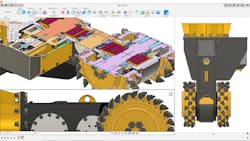The prototyping stage is the perfect time in a product’s design cycle to consider DFM (design for manufacturing). Companies are well aware that products go through multiple iterations before the perfect design is achieved. Prototyping is where engineers discover design challenges, test form and fit requirements, receive feedback, make improvements, and consider what machinery will be needed for production — and if any specialized processes are necessary.
Product prototyping stages are rarely linear and are filled with potential challenges. Traditional manufacturing and design tools force fragmented workload organization. This encourages teams to create shortcuts to save time, eliminating the opportunity for experimentation during prototyping and reducing the chances of creating the best products.
Prototyping to Production
For best practices, engineers need to move back and forth between 3D modeling, simulation, electronics, and production — including machine tool path flows, additive manufacturing processes, injection molding simulation, and more. Having the capacity to do all the steps from design to production in one place, using tools like Autodesk Fusion 360, eliminates the siloed working habits and shortcuts reluctantly accepted by most operations.
Design for manufacturing goals include ease of manufacturing, speed of manufacturing, optimization of resources, and a consideration of overall costs. Ideally, the DFM team includes multiple stakeholders, including in-house design teams, outsourced vendors, material suppliers, and anyone else who can offer insight. The concept is to make sure that all unnecessary costs are eliminated.
Companies who consider prototyping and DFM simultaneously get a head start on lowering costs by creating a product whose prototyping iterations have included DFM elements from the beginning. It’s important to note that this type of thinking is also important when redesigning or upgrading a previous design. Mistakes made in an older design can easily be brought forward and repeated if every aspect of the design isn’t reevaluated.Tying Prototyping to Design for Manufacturing
It may seem odd to consider what machine will be used to produce a product before the design is fully realized, but that is exactly what must be done to keep your final costs at their lowest. Quantity is also considered during these early stages of design. Why use highly capitalized equipment that requires tools and dies for a low-quantity product? Why use a process like 3D printing that can only produce one product at a time if you are designing a high-volume product? Besides quantity, you’ll want to consider material choices, surface complexities, tolerances, and secondary processes. These considerations will be repeated throughout your design, of course, but if you keep your manufacturing capabilities top of mind, these items will begin to come together more easily.
With manufacturing capabilities in mind, engineers working on the design prototypes can immediately start thinking about what parts of the design might challenge the process and solve those problems up front. Where can specifications be loosened, and where must they be tight? Where is fit more important than form? What material options are available? Using tools that allow for seamless interaction between collaborators, such as Fusion 360, ensures that product designers can integrate DFM considerations smoothly throughout every design step. Depending on the project, contractors and clients can be invited to use the same tools to communicate and collaborate.
Additional Manufacturing Considerations
Another consideration is to design your prototypes to focus on the environment the product will be used and the environment where it will be produced. A manufacturing process may expose the product to higher temperatures, more chemicals, or more vibration than the end product is expected to experience. This also goes for material properties. How strong does the
material need to be? The manufacturing and assembly process may be harsher than general use once the product is in the world. Other material concerns might include optical properties, thermal stability, electrical resistance, and flammability. When engineers have manufacturing in mind, better decisions can be made in the prototyping stage. For example, an engineer might choose to avoid using a customized material that would also require customized processes — both of which would add cost to the final product.
Keeping DFM in mind during prototyping gives your designers a chance to think of ways to minimize part counts. Where can one structure be created instead of two that must be bolted or glued together? Creating multi-functional parts and even multi-functional products also decreases overall part counts — think across product designs. Designing parts with more than one function, such as spacers used in one design, could be used as standoffs in another design if the spacers are designed with holes through their centers.
Using Fusion 360 allows users to simulate designs without going through the build process, saving design time as well as material and labor costs. Designs can often be separated and thought of as a series of modules. This is particularly valuable when a project is being designed that requires interchangeable functionality. If your product has several versions, modularization can save on production and materials if one version sells better than another. A latch/handle combination that is modular can be used in multiple designs, sometimes as one piece and sometimes separately. Think of multi-functional products like a printer/copier/scanner. If designed modularly, each could be sold separately with minor modifications. Such opportunities offer a quick way to lower overall production costs on particular products and product lines. Using Fusion 360 simulation tools allows you to predict the manufacturing impact on each design long before the product goes to manufacturing.
Design for manufacturing includes assembly, which means that your prototype should consider multiple aspects of joining and sealing, including screws, nuts and bolts, adhesives, or snap-together approaches. While screws or adhesives might be inexpensive, there are increases in labor costs during assembly. Whenever you can produce a part that takes less assembly, you save manufacturing and assembly time. Designing your prototype while considering how much handling is needed before reaching the completed product stage can save resources as well as materials.High-Throughput Markets
Fusion 360 provides fully functional CAD, CAM, CAE, and PCB tools, which enables teams to explore multiple design iterations while focusing on the best production processes. Fusion 360 allows both internal and external teams to use the same tools for seamless collaboration from prototype to production. By increasing product development agility in this way, companies are also able to increase manufacturing throughput. This is especially key for high-throughput markets like consumer products. Automation collaboration tools with full software interoperability reduce non-value-added processes from design inception through manufacturing while continually considering methods and costs along the way. Just as you want to standardize your materials and processes, standardizing your software tools provides greater capabilities, including seamless collaboration, simulation, and fabrication.
Remember, design decisions focusing on DFM can reduce materials, manufacturing, and assembly costs on any product or group of products. In addition, thinking in terms of modularity and multi-use products and components can decrease the number of parts that need to be designed. If one component can be used for multiple low-volume products, you gain the benefits of high-volume production for that component, which affects the cost of multiple products.
Ready to streamline your product development process? Try Fusion 360 for free today.


